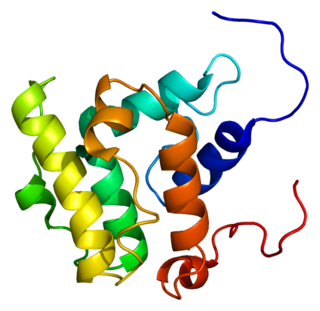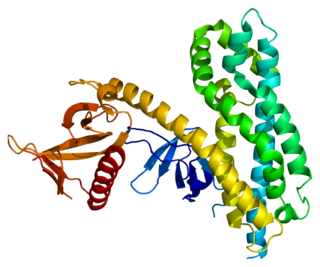
Guanine nucleotide exchange factors (GEFs) are proteins or protein domains that activate monomeric GTPases by stimulating the release of guanosine diphosphate (GDP) to allow binding of guanosine triphosphate (GTP). A variety of unrelated structural domains have been shown to exhibit guanine nucleotide exchange activity. Some GEFs can activate multiple GTPases while others are specific to a single GTPase.
The Rho family of GTPases is a family of small signaling G proteins, and is a subfamily of the Ras superfamily. The members of the Rho GTPase family have been shown to regulate many aspects of intracellular actin dynamics, and are found in all eukaryotic kingdoms, including yeasts and some plants. Three members of the family have been studied in detail: Cdc42, Rac1, and RhoA. All G proteins are "molecular switches", and Rho proteins play a role in organelle development, cytoskeletal dynamics, cell movement, and other common cellular functions.

Cell division control protein 42 homolog is a protein that in humans is encoded by the CDC42 gene. Cdc42 is involved in regulation of the cell cycle. It was originally identified in S. cerevisiae (yeast) as a mediator of cell division, and is now known to influence a variety of signaling events and cellular processes in a variety of organisms from yeast to mammals.

FYVE, RhoGEF and PH domain-containing protein 1 (FGD1) also known as faciogenital dysplasia 1 protein (FGDY), zinc finger FYVE domain-containing protein 3 (ZFYVE3), or Rho/Rac guanine nucleotide exchange factor FGD1 is a protein that in humans is encoded by the FGD1 gene that lies on the X chromosome. Orthologs of the FGD1 gene are found in dog, cow, mouse, rat, and zebrafish, and also budding yeast and C. elegans. It is a member of the FYVE, RhoGEF and PH domain containing family.

Transforming protein RhoA, also known as Ras homolog family member A (RhoA), is a small GTPase protein in the Rho family of GTPases that in humans is encoded by the RHOA gene. While the effects of RhoA activity are not all well known, it is primarily associated with cytoskeleton regulation, mostly actin stress fibers formation and actomyosin contractility. It acts upon several effectors. Among them, ROCK1 and DIAPH1 are the best described. RhoA, and the other Rho GTPases, are part of a larger family of related proteins known as the Ras superfamily, a family of proteins involved in the regulation and timing of cell division. RhoA is one of the oldest Rho GTPases, with homologues present in the genomes since 1.5 billion years. As a consequence, RhoA is somehow involved in many cellular processes which emerged throughout evolution. RhoA specifically is regarded as a prominent regulatory factor in other functions such as the regulation of cytoskeletal dynamics, transcription, cell cycle progression and cell transformation.

RhoGEF domain describes two distinct structural domains with guanine nucleotide exchange factor (GEF) activity to regulate small GTPases in the Rho family. Rho small GTPases are inactive when bound to GDP but active when bound to GTP; RhoGEF domains in proteins are able to promote GDP release and GTP binding to activate specific Rho family members, including RhoA, Rac1 and Cdc42.

Rho guanine nucleotide exchange factor 7 is a protein that in humans is encoded by the ARHGEF7 gene.

Rho guanine nucleotide exchange factor 6 is a protein that, in humans, is encoded by the ARHGEF6 gene.

Rho guanine nucleotide exchange factor 11 is a protein that in humans is encoded by the ARHGEF11 gene. This protein is also called RhoGEF11 or PDZ-RhoGEF.

Rho guanine nucleotide exchange factor 12 is a protein that in humans is encoded by the ARHGEF12 gene. This protein is also called RhoGEF12 or Leukemia-associated Rho guanine nucleotide exchange factor (LARG).

RhoG is a small monomeric GTP-binding protein, and is an important component of many intracellular signalling pathways. It is a member of the Rac subfamily of the Rho family of small G proteins and is encoded by the gene RHOG.

Guanine nucleotide exchange factor VAV3 is a protein that in humans is encoded by the VAV3 gene.

Guanine nucleotide exchange factor DBS is a protein that in humans is encoded by the MCF2L gene.
Rac is a subfamily of the Rho family of GTPases, small signaling G proteins. Just as other G proteins, Rac acts as a molecular switch, remaining inactive while bound to guanosine diphosphate (GDP) and activated once guanine nucleotide exchange factors (GEFs) remove GDP, permitting guanosine triphosphate (GTP) to bind. When bound to GTP, Rac is activated. In its activated state, Rac participates in the regulation of cell movement, through its involvement in structural changes to the actin cytoskeleton. By changing the cytoskeletal dynamics within the cell, Rac-GTPases are able to facilitate the recruitment of neutrophils to the infected tissues, and to regulate degranulation of azurophil and integrin-dependent phagocytosis.

Dedicator of cytokinesis protein 10 (Dock10), also known as Zizimin3, is a large protein involved in intracellular signalling networks that in humans is encoded by the DOCK10 gene. It is a member of the DOCK-D subfamily of the DOCK family of guanine nucleotide exchange factors, which function as activators of small G-proteins.

Guanine nucleotide-binding protein subunit alpha-12 is a protein that in humans is encoded by the GNA12 gene.

Rho guanine nucleotide exchange factor 4 is a protein that in humans is encoded by the ARHGEF4 gene.

Dedicator of cytokinesis protein 6 (Dock6), also known as Zir1 is a large protein encoded in the human by the DOCK6 gene, involved in intracellular signalling networks. It is a member of the DOCK-C subfamily of the DOCK family of guanine nucleotide exchange factors which function as activators of small G-proteins.

Dedicator of cytokinesis protein 11 (Dock11), also known as Zizimin2, is a large protein encoded in the human by the DOCK11 gene, involved in intracellular signalling networks. It is a member of the DOCK-D subfamily of the DOCK family of guanine nucleotide exchange factors (GEFs) which function as activators of small G-proteins. Dock11 activates the small G protein Cdc42.

The Rho GTPase activating protein 31 is encoded in humans by the ARHGAP31 gene. It is a Cdc42/Rac1 GTPase regulator.




















